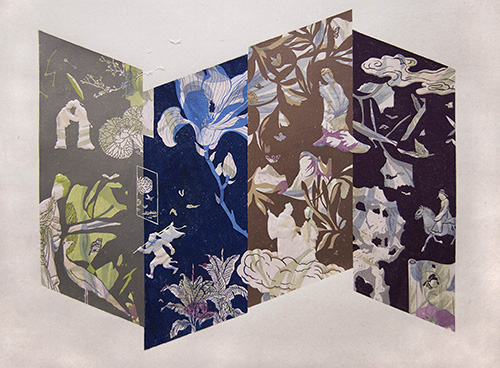The first step in printmaking has from the earliest times to the present day been the sketching by the artist of the outlines of the image. The character and significance of the finalized drawing depends solely on how the artist acts and works on his hunch, or the intuitive, mental representational image of an object or scene. Some printmakers only imitate what they see, the only objective being the reproduction of similar illustrations. Others are more free-spirited, expressing their uniqueness and individuality with each cutting stroke in a style that is natural and flowing.
On view in this section are contemporary prints which have their roots in illustrated works from historical China, as a manifestation of how the artists of today have integrated what is traditional into their innovative styles in the presentation of subject matters, the application of engraving techniques, and the execution of printmaking procedures. Today, book illustrations no longer play the kind of supportive role as they did in the past to illuminate the meaning of texts; they are genuine works of art on their own merits. Printmakers today have a dual role; they are painters and engravers at the same time. With the faith that “life itself should be beautiful” they are committed to making their prints visible on small daily objects. Indeed, it is through these types of print works that we can feel and sense the ingenuity of the printmakers of our time.
A Dream of Wandering in a Garden
- Techniques: Multiple-plate linocut, Chinese col-lage, and embossing
- Year of composition: 2015
- Domension: 47 x 40 cm
I dream of a picturesque vision and tangible illusion,
One alluring smile abashes the charm of changing seasons.
Resurrected for love, Liniang again savors the infinite beauty of the four seasons.
The episode of Jingmeng (Waking from a Dream), a blending of Zaju (poetic drama and acrobatics set to music) and Kunqu (Kun opera), is rendered in both dounban color printing and gonhua relief printing.
What is engraved here is the eternal yearning for love; what is captured by the brush is lovesickness and the parting sorrow beyond words.
I wish to depict the sweet moment of the couple listening to the music of zither in the shade of plantain; I wish to pen the desperate resignation behind the romance of butterfly lovers.
These are all just fanciful thought of the past. Between texts and images, my fanciful thoughts travel back to Mengmei and Junrei with curiosity.
Just like the everlasting stream winding through crevices of rocks and between blossoming groves, the coiling and twisting red threads of fate are always entangled with our heartstrings.
Hundreds of years have gone by, and today the garden is revisited.
I was invited by the National Palace Museum to make the print Meng Youyuan (A Dream of Wandering in a Garden). In the process of production, I explored repeatedly the features of various print works made during the Ming and Qing dynasties, and studied extensively the illustrations in the rare books in the Museum’s collection, immersing myself in the leaves of books and stationery paper showcasing the extraordinary achievements of those before us who were constantly in pursuit of the highest state of painting, engraving and printing. Bit by bit, I relished and ruminated over the entangled romances of literary classics between the lines of opera and theatrical pieces. This led to a determination to deliver a piece which talks back to the lifetime passion of these predecessors and reconstruct the interdependency between texts and illustrations.
Amongst the considerable number of classic texts with illustrations in the collection, what fascinated me the most is the act Kuijian (Peeping at the Letter) by the artist Chen Hongshou from Xixiang Ji (Romance of the West Chamber) where the subtle juxtaposition of the two protagonists and folding screens highlights their connection and embodies multiple metaphors. Therefore, I have decided to reconstruct various scenes of the four seasons into the composition. The folding screens and the transitioning of space set forth the actions and tension of plots. Although it is based on different texts from different eras, the theme of love’s struggle and strife remains the same. The last scene presents flying butterflies, as a gesture of paying tribute to the romantic declaration of the metamorphosis of star-crossed lovers into butterflies.



